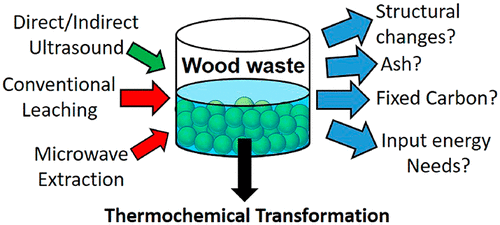当前位置:
X-MOL 学术
›
ACS Sustain. Chem. Eng.
›
论文详情
Our official English website, www.x-mol.net, welcomes your
feedback! (Note: you will need to create a separate account there.)
Augmented Leaching Pretreatments for Forest Wood Waste and Their Effect on Ash Composition and the Lignocellulosic Network
ACS Sustainable Chemistry & Engineering ( IF 7.1 ) Pub Date : 2020-04-01 , DOI: 10.1021/acssuschemeng.0c00351 Martin J. Taylor 1, 2 , Hassan A. Alabdrabalameer 2 , Apostolos K. Michopoulos 3 , Roberto Volpe 4 , Vasiliki Skoulou 1, 2
ACS Sustainable Chemistry & Engineering ( IF 7.1 ) Pub Date : 2020-04-01 , DOI: 10.1021/acssuschemeng.0c00351 Martin J. Taylor 1, 2 , Hassan A. Alabdrabalameer 2 , Apostolos K. Michopoulos 3 , Roberto Volpe 4 , Vasiliki Skoulou 1, 2
Affiliation

|
By augmenting conventional leaching technologies for the removal of ash constituents from lignocellulosic waste residues, a cleaner and energy efficient solution can be provided for critical industrial problems such as biomass feeding, defluidization, and reactor corrosion. It has been found that not only are inorganic constituents (ash) effectively removed by coupling a physicochemical technology with conventional leaching but also the intermolecular interactions within the lignocellulosic matrix can be modified, as shown by a variable crystallinity index (powder X-ray diffraction) without the loss of physical bonding (Fourier-transform infrared spectroscopy). Ultimately, this allowed for a greater thermochemical transformation of cellulose, hemicellulose, and lignin for all technologies used: conventional leaching, indirect/directed ultrasound, and microwave irradiation. However, the use of directed ultrasound was found to be the standout, energy efficient technology (8.6 kJ/g) to radically improve the thermochemical transformation of wood waste, especially in the reduction of fixed carbon at high temperatures. It was also found to be efficient at removing vital eutectic mixture causing elements, including Si, which is known to be notoriously difficult to remove via leaching. In comparison, hot plate leaching and microwave irradiation use 39 and 116 times more energy, respectively. The integration of this technology into the energy production sector will prove vital in the future due to its scalability, as compared with microwave alternatives, which are currently not suitable for large scale operations. Additionally, the residence time required for directed ultrasound was found to be negligible as compared to the various other physicochemical techniques, 0.1 h opposed to 4 h.
中文翻译:

森林木材废物强化浸出预处理及其对灰分组成和木质纤维素网络的影响
通过增加用于从木质纤维素废渣中去除灰分成分的常规浸出技术,可以为关键的工业问题(如生物质进料,脱液和反应堆腐蚀)提供更清洁,节能的解决方案。已经发现,不仅可以通过将物理化学技术与常规浸出相结合,有效地去除无机成分(灰分),而且可以改变木质纤维素基质内的分子间相互作用,如可变的结晶度指数(粉末X射线衍射)所示。不会损失物理键合(傅立叶变换红外光谱)。最终,这使得纤维素,半纤维素和木质素在所用的所有技术上都可以实现更大的热化学转化:常规浸提,间接/定向超声,和微波照射。然而,发现使用定向超声是一种显着的节能技术(8.6 kJ / g),可以从根本上改善木材废料的热化学转化,尤其是在高温下减少固定碳的过程中。还发现,它有效地去除了引起重要的共晶混合物的元素,包括硅,众所周知,众所周知,这种元素很难通过浸提去除。相比之下,热板浸出和微波辐射分别消耗39倍和116倍的能量。与目前不适合大规模运营的微波替代品相比,由于其可扩展性,将该技术集成到能源生产领域将在未来变得至关重要。另外,
更新日期:2020-04-01
中文翻译:

森林木材废物强化浸出预处理及其对灰分组成和木质纤维素网络的影响
通过增加用于从木质纤维素废渣中去除灰分成分的常规浸出技术,可以为关键的工业问题(如生物质进料,脱液和反应堆腐蚀)提供更清洁,节能的解决方案。已经发现,不仅可以通过将物理化学技术与常规浸出相结合,有效地去除无机成分(灰分),而且可以改变木质纤维素基质内的分子间相互作用,如可变的结晶度指数(粉末X射线衍射)所示。不会损失物理键合(傅立叶变换红外光谱)。最终,这使得纤维素,半纤维素和木质素在所用的所有技术上都可以实现更大的热化学转化:常规浸提,间接/定向超声,和微波照射。然而,发现使用定向超声是一种显着的节能技术(8.6 kJ / g),可以从根本上改善木材废料的热化学转化,尤其是在高温下减少固定碳的过程中。还发现,它有效地去除了引起重要的共晶混合物的元素,包括硅,众所周知,众所周知,这种元素很难通过浸提去除。相比之下,热板浸出和微波辐射分别消耗39倍和116倍的能量。与目前不适合大规模运营的微波替代品相比,由于其可扩展性,将该技术集成到能源生产领域将在未来变得至关重要。另外,











































 京公网安备 11010802027423号
京公网安备 11010802027423号